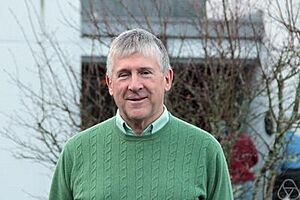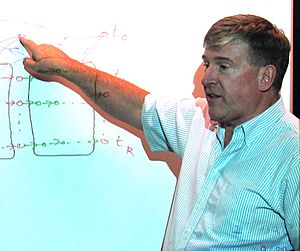Paul Seymour (mathematician) facts for kids
Quick facts for kids
Paul Seymour
|
|
|---|---|

Seymour at Oberwolfach in 2016
|
|
| Education | Exeter College, Oxford (BA 1971, DPhil 1975) |
| Awards | Sloan Fellowship (1983) Ostrowski Prize (2003) George Pólya Prize (1983, 2004) Fulkerson Prize (1979, 1994, 2006, 2009) |
| Scientific career | |
| Institutions |
|
| Thesis | Matroids, Hypergraphs and the Max-Flow Min-Cut Theorem (1975) |
| Doctoral advisor | Aubrey William Ingleton |
| Doctoral students | Maria Chudnovsky Sang-il Oum |
Paul D. Seymour is a British mathematician who studies discrete mathematics. This field of math deals with things that can be counted, like graphs and networks. He is especially famous for his work in graph theory, which uses graphs to solve problems.
Paul Seymour has made big steps forward in understanding many complex math ideas. These include the four-color theorem and graph minors. He is currently a professor of mathematics at Princeton University.
He has won many awards for his work. These include the Sloan Fellowship in 1983 and the Ostrowski Prize in 2003. He also won the Fulkerson Prize four times (1979, 1994, 2006, 2009). He received the Pólya Prize in 1983 and 2004. In 2022, he became a Fellow of the Royal Society, a very important science group.
Contents
Early Life and Education
Paul Seymour went to school at Plymouth College. After that, he studied at Exeter College, Oxford University. He earned his first degree, a Bachelor of Arts (BA), in 1971.
He continued his studies and received his Doctor of Philosophy (D.Phil.) degree in 1975. His main project for this degree was called Matroids, Hypergraphs and the Max-Flow Min-Cut Theorem. His professor, Aubrey William Ingleton, helped guide his research.
Career Highlights
After finishing his studies, Paul Seymour worked at several universities. From 1974 to 1976, he was a research fellow at University College of Swansea. He then returned to Oxford from 1976 to 1980. During this time, he also spent a year (1978–1979) at the University of Waterloo in Canada.
From 1980 to 1983, he was a professor at Ohio State University. Here, he started working with another mathematician, Neil Robertson. They worked together for many years and made important discoveries.
From 1983 to 1996, Seymour worked at Bellcore, a research company. He also taught part-time at Rutgers University and the University of Waterloo. In 1996, he became a professor at Princeton University, where he still teaches today.
He also helps edit important math journals. These include the Journal of Graph Theory and Combinatorica.
Family Life
Paul Seymour has a brother named Leonard W. Seymour. Leonard is also a professor, teaching about gene therapy at Oxford University.
Major Discoveries in Mathematics
Paul Seymour's early work focused on matroid theory. This is a part of math that studies how different sets of things can be connected. He won his first Fulkerson Prize for his work on matroids. He also showed how certain matroids could be put together from simpler parts, which earned him his first Pólya Prize.
He also worked on other interesting problems. He helped show that all graphs without "bridges" (edges that, if removed, would split the graph into two parts) can have their edges colored in a special way. This was a step towards solving a famous math puzzle called Tutte's nowhere-zero 5-flow conjecture.
The Graph Minors Project
In 1980, Paul Seymour began working with Neil Robertson. This led to their most famous work, the "Graph Minors Project." They published 23 papers over 30 years.
Some of their key findings include:
- The graph minors structure theorem: This helps us understand how complex graphs are built.
- Proving a conjecture by Wagner: They showed that in any endless group of graphs, one graph will always be a "minor" of another. This means you can get one graph from another by removing edges or shrinking parts.
- Developing fast ways to check if a graph contains a smaller graph as a minor.
Working with Robin Thomas
Around 1990, Robin Thomas joined Robertson and Seymour. Together, they made more important discoveries:
- They proved a conjecture by Sachs about graphs that can be drawn in 3D space without links.
- They helped create a simpler, computer-based proof for the four-color theorem. This theorem states that any map can be colored with only four colors so that no two neighboring regions have the same color.
Recent Work
In the 2000s, Seymour and his team worked on the strong perfect graph conjecture. This was a big unsolved problem in math since the 1960s. In 2002, Seymour, his student Maria Chudnovsky, and others proved this conjecture.
Seymour continued to work with Chudnovsky. They found ways to test if a graph is "perfect" using computers. They also described all "claw-free graphs," which are graphs that don't have a specific star-like shape.
More recently, in the 2010s, Seymour focused on χ-boundedness and the Erdős–Hajnal conjecture. He worked with Alex Scott and Maria Chudnovsky on these problems. They proved that graphs with certain properties must contain specific types of cycles. They also found a fast way to check if a graph has an "induced cycle" that is long and has an odd number of edges.
Their work has helped solve parts of the Erdős–Hajnal conjecture. This conjecture is about finding large groups of connected or unconnected points in graphs that don't have certain patterns.
See also
- Robertson–Seymour theorem
- Strong perfect graph theorem


